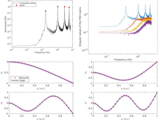Automated Frequency Domain Decomposition (AFDD)
Automated Modal parameters identification from ambient vibrations measurement
The automated Frequency Domain Decomposition presented was applied in [1]. It inspired by the Frequency Domain Decomposition (FDD) introduced by [2, 3]. The goal is to identify the mode shapes, eigenfrequencies and modal damping ratios from acceleration records obtained during structural health monitoring of civil engineering structures subjected to ambient noise. In this submission, an automated procedure is implemented in addition to the manual one proposed by [4]. For the automated procedure, I am using the peak picking function “pickpeaks” developed by [5] and available in [6], which was much more efficient than the Matlab function "findpeaks" for this purpose. I am, therefore, indebted to [4-6] for their previous works. The modal damping ratios are determined for each mode by using [7]. The acceleration data comes from a time-domain simulation of a clamped-free beam response to white noise excitation. The target modal properties from the beam come from [8].
The submission contains:
- The function AFDD
- A Matlab livescript file Documentation.mlx
- Acceleration data beamData.m (4 Mb)
- The function pickpeaks.m [6]
Any comment, suggestion and question is welcome.
[1] Cheynet, E., Jakobsen, J. B., & Snæbjörnsson, J. (2017). Damping estimation of large wind-sensitive structures. Procedia engineering, 199, 2047-2053.
[2] Brincker, R.; Zhang, L.; Andersen, P. (2001). "Modal identification of output-only systems using frequency domain decomposition". Smart Materials and Structures 10 (3): 441. doi:10.1088/0964-1726/10/3/303.
[3] Brincker, R., Zhang, L., & Andersen, P. (2000, February). Modal identification from ambient responses using frequency domain decomposition. In Proc. of the 18*‘International Modal Analysis Conference(IMAC), San Antonio, Texas.
[4] https://se.mathworks.com/matlabcentral/fileexchange/50988-frequency-domain-decomposition--fdd-
[5] Antoine Liutkus. Scale-Space Peak Picking. [Research Report] Inria Nancy - Grand Est (Villers-lès-Nancy, France). 2015. .
[6] https://se.mathworks.com/matlabcentral/fileexchange/42927-pickpeaks-v-select-display-
Cita come
Cheynet, Etienne, et al. “Damping Estimation of Large Wind-Sensitive Structures.” Procedia Engineering, vol. 199, Elsevier BV, 2017, pp. 2047–53, doi:10.1016/j.proeng.2017.09.471.
Compatibilità della release di MATLAB
Compatibilità della piattaforma
Windows macOS LinuxCategorie
- Control Systems > System Identification Toolbox > Linear Model Identification >
- Engineering > Mechanical Engineering > Acoustics, Noise and Vibration >
Tag
Riconoscimenti
Ispirato da: pickpeaks(V,select,display), Frequency Domain Decomposition (FDD), eigen-value calculation of continuous beams, Damping ratio estimation from ambient vibrations (SDOF)
Community Treasure Hunt
Find the treasures in MATLAB Central and discover how the community can help you!
Start Hunting!Scopri Live Editor
Crea script con codice, output e testo formattato in un unico documento eseguibile.
| Versione | Pubblicato | Note della release | |
|---|---|---|---|
| 1.7 | See release notes for this release on GitHub: https://github.com/ECheynet/AFDD/releases/tag/v1.7 |
||
| 1.6 | See release notes for this release on GitHub: https://github.com/ECheynet/AFDD/releases/tag/v1.6 |
||
| 1.5 | Added project website |
||
| 1.4.1.0 | Picture and some typo in the example file |
||
| 1.4.0.0 | The user can now specify the lower and upper boundaries for the spectral peaks associated with the identified eigen frequencies. An additional example is given in Example2.m to illustrate the use of this new option. |
||
| 1.3.0.0 | - Some useless elements have been removed, in particular one calling for the mapping toolbox. |
||
| 1.2.0.0 | The modal damping ratio is now correctly displayed in Example2.m |
||
| 1.1.0.0 | typo
|
||
| 1.0.0.0 |
typo again
|




